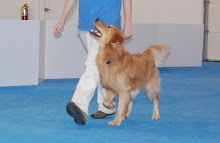I'll admit that I don't usually plan ahead on how to respond to errors, but I've been training long enough that I typically make good responses. For me, it's hardest in a class environment where I know what -I- would do, but I don't know what the instructor wants me to do.
With incorrect responses we need to know what happened before the error and what's happened since the error and remember that when we do reinforce....we want to be sure we're not unintentionally reinforcing the incorrect behaviors. And that's confusing and complex.
---------------------------------------------------
Last night Griffin and I stopped in a town (city? place?) on the way home from the handling lab. All I had left was about 10 tiny pieces of bread and a bunch of kibble. Surprisingly Griffin was eating and then working for the kibble. We did some obedience chains and pieces. It went beautifully and I left thinking, "Wow, he did everything very, very right or very, very wrong." And then I realized that's how he does just about everything.
Blaze and Luna both have a number of behaviors that vary in precision. They'll auto sit, but not always quite parallel or not quite fast enough.
And that thought was followed with, "Well, shouldn't training always be like that? Right or wrong? It can't be in between. We either accept it or not." And that's why Griffin is more precise. I'm just more careful about what to accept or not. And while we love shaping and use it for many things, unlike with Luna and Blaze, I haven't done a lot of "free shaping heel" and "gradually increase criteria for parallel sits.". We've used completely different training plans for those concepts and Heel is only associated with straightness (taught via the pivot boxes). For most behaviors Griffin is clearly correct or not.
That said...I'm unfortunately human and we get sloppy on occasion. He's very cute and forces me to reinforce behaviors I shouldn't.
------------------------------------------------
Summary points:
Make a plan.
Plan response to errors.
Avoid creating chains of error-correct-reinforce.
Prevent errors.
Maintain criteria!
Adjust appropriately.





No comments:
Post a Comment